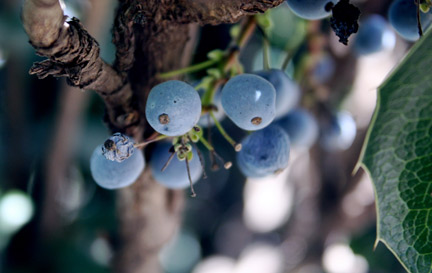

The body mounts a systemic response to bitter plants as a way to manage the possibility of poisoning. As I described in my Bitters article, humans have co-evolved with bitter tasting plants and the body perceives of some bitter tastes as poisonous. The bitterness of the herb signifies its medicinal value in a number of areas. The most important factors associated with Oregon Grape root is that it is quite bitter and that it carries the alkaloid berberine. Oregon Grape flower essence is offered to strengthen a sense of trust in ourselves, our strength and beauty without giving power away to others. One can also work with the flower as a flower essence. Often its best to mix the berries in with sweeter berries such as blueberries and salal berries. A lot of sweetener is needed as the berries are extremely tart. The root carries most of the medicine but one can also gather the berries to make jams and jellies. After gathering the roots, the upper stem can be cut and actually replanted in soil to replace what has been gathered. The dwarf Oregon Grape has rhizomatous roots that are more shallow and can be simply pulled up and then cut. The larger Oregon Grape is somewhat harder to gather as the taproot is bigger and deeper. Oregon Grape is rhizomatous so gathering one or two plants from a large clan of interconnected Oregon Grapes in the wild is okay if done with the utmost care. If one chooses to wildcraft the herb it is key that one understands the ecosystem and avoid damaging the population of Oregon Grape. The best way to work with this plant is to purchase the root from a reputable Oregon Grape farmer or from a vendor connected to that farmer. Like most roots, harvesting is best done in the early spring or late fall when the plant reduces valuable energy to outer leaves and flowers and the valuable root constituents are most readily available. If you scrape back some of the root bark you will find the golden yellow inner bark that is rich in the important alkaloid berberine. The main portion of Oregon Grape that is valuable is the inner stem bark of Oregon Grape. The floral industry value Oregon Grape for its foliage and foragers can do quite a bit of damage through overharvesting this important plant. Oregon Grape can be grown in farms for its medicinal value and should be very carefully and ethically gathered in the wild as we don’t want to damage the population of this amazing plant. Oregon Grape is native to North America and grows throughout much of the country. All three have holly like glossy, leathery and spiny leaves that can sometimes turn from green to red and yellow late in the season.

Finally there is creeping Oregon Grape (Mahonia repens) that grows very low to the ground. While the tall Oregon Grape has 5-7 leaflets, the low Oregon Grape has 9-19 leaves. Mahonia nervosa, known as dwarf or low Oregon Grape is found mainly in the woods and is more shade loving and much smaller- usually growing only a foot or two tall. The tall sun loving Mahonia aquifolium grows to 6 feet tall and has a deep thick tap root that offers the most medicine of the three species. There are several main species of Oregon Grape and all are useful for their medicinal value.


 0 kommentar(er)
0 kommentar(er)
